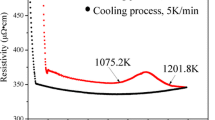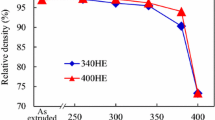Abstract
(Bi,Sb)2Te3 + 4 mol%PbTe was quenched in water and on a rotating copper wheel (melt spinning). It was found that PbTe was immiscible in (Bi,Sb)2Te3 when the material is quenched in water and that the thermoelectric figure of merit increases by annealing. Natural nanostructures (nns) were found in melt-spun (Bi,Sb)2Te3, whereas they were hard to detect in (Bi,Sb)2Te3 alloyed with PbTe. There is a correlation between the orientation of the strain field and the nns. Within the grains of melt-spun (Bi,Sb)2Te3 alloyed with PbTe, the chemical composition was homogeneous. An enrichment of Pb was found at the grain boundaries. Quenched (Bi,Sb)2Te3 alloyed with 0.3 wt%PbTe have been spark plasma sintered (SPS). After optimization, the Seebeck coefficients of the melt-spun SPS (MS-SPS) materials were larger than for materials quenched in water and sintered (QW-SPS) materials. In addition, the mobility increases with the carrier concentration in MS-SPS materials, whereas it decreases in QW-SPS materials.
















Similar content being viewed by others
Change history
01 September 2011
An Erratum to this paper has been published: https://doi.org/10.1557/jmr.2011.312
REFERENCES
T.M. Tritt: Harvesting energy through thermoelectrics: Power generation and cooling. MRS Bull. 31, 188 (2006).
H. Böttner, D.G. Ebling, A. Jacquot, J. König, L. Kirste, and J. Schmidt: Structural and mechanical properties of sparc plasma sintered n- and p-type bismuth telluride alloys. Phys. Status Solidi RRL 1(6), 235 (2007).
D.G. Ebling, A. Jacquot, M. Jägle, H. Böttner, U. Kühn, and L. Kirste: Structure and thermoelectric properties of nanocomposite bismuth telluride prepared by melt spinning or by partially alloying with IV–VI compounds. Phys. Status Solidi RRL 1(6), 238 (2007).
B. Dado, Y. Gelbstein, D. Mogilansky, V. Ezersky and M.P. Dariel: Structural evolution following spinodal decomposition of the pseudoternary compound (Pb0.3Sn0.1Ge0.6). J. Electron. Mater. 39(9), 2165 (2010).
Y. Gelbstein, B. Dado, O.B. Yehuda, Y. Sadia, Z. Dashevsky, and M.P. Dariel: High thermoelectric figure of merit and nanostructuring in bulk p-type Gex(SnyPb1-y)1-xTe alloys following a spinodal decomposition reaction. Chem. Mater. 22, 1054 (2010).
M.S. Dresselhaus, G. Chen, Z.F. Ren, G. Dresselhaus, A. Henry, and J.-P. Fleurial: New composite thermoelectric materials for energy harvesting applications. JOM 61(4), 86 (2009).
N. Peranio, O. Eibl, and J. Nurnus: Structural and thermoelectric properties of epitaxially grown Bi2Te3 thin films and superlattices. J. Appl. Phys. 100, 114306 (2006).
V.M. Glazov and Yu.V. Yatmanov: Thermoelectric properties of semiconducting solid solutions Bi2Te2.4Se0.6 and Bi0.52Sb1.48Te3 prepared by ultrafast cooling melts. Moscow Institute of Electronics. Translated from Izvestiya Akademii Nauk SSSR. Neorganicheskie Materialy, Vol. 22, No. 1, pp. 36–40, January, 1986. Original 23 (1984) (article submitted).
E. Koukharenkou, N. Fretya, V.G. Shepelevich, and C. Tedenac: Electrical properties of Bi2-xSbxTe3 materials obtained by ultrarapid quenching. J. Alloy. Comp. 327, 1 (2001).
D.G. Ebling, A. Jacquot, H. Böttner, L. Kirste, and J. Schmidt: Influence of group IV-Te alloing on nanocompiste structure and thermoelectric properties of Bi2Te3 compounds. J. Electron. Mater. 38(7), 1450 (2009).
J. Jiang, L. Chen, S. Bai, Q. Yao, and Q. Wang: Fabrication and thermoelectric performance of textured n-type Bi2(Te, Se)3 by spark plasma sintering. Mater. Sci. Eng., B 117, 334 (2005).
C.H. Lim, K.T. Kim, Y.H. Kim, Y.S. Lee, C.H. Lee, and C.H. Lee: Improvement of the figure-of-merit by formation of crystallographic texture in Bi2Te3-based thermoelectric compounds. J. Electroceram. 17, 894 (2006).
Z.-C. Chen, K. Suzuki, S. Miura, K. Nishimura, and K. Ikeda: Microstructural features and deformation-induced lattice defects in hot-extruded Bi2Te3 thermoelectric compound. Mater. Sci. Eng., A 500, 70 (2009).
Y. Ma, Q. Hao, B. Poudel, Y. Lan, B. Yu, D. Wang, G. Chen, and Z. Ren: Structure study of bulk nanograined thermoelectric bismuth antimony telluride. Nano Lett. 8(8), 2580 (2008).
W. Xie, J. He, H.J. Kang, X. Tang, S. Zhu, M. Laver, S. Wang, J.R.D. Copley, C.M. Brown, Q. Zhang, and T.M. Tritt: Identifying the specific nanostructures responsible for the high thermoelectric performance of (Bi, Sb)2Te3 nanocomposites. Nano Lett. 10, 3283 (2010).
W. Xie, X. Tang, Y. Yan, Q. Zhang, and T.M. Tritt: High thermoelectric performance BiSbTe alloy with unique low-dimensional structure. J. Appl. Phys. 105, 113713 (2009).
N. Peranio and O. Eibl: Quantitative EDX microanalysis of Bi2Te3 in the TEM. Phys. Status Solidi A 204(10), 3243 (2007).
P. Stadelmann: EMS—a software package for electron diffraction analysis and HREM image simulation in materials science. Ultramicroscopy 21, 131 (1987).
J. Thomas and T. Gemming: ELDISCA C#—a new version of the program for identifying electron diffraction patterns, in EMC 2008, Vol. I, (Aachen, 2008), pp. 231–232.
M.M. Stasova and N.K. Abrikosov: The radiographical analysis of the solid solution in system Bi-Sb-Te. Izvestiya Akademii Nauk SSSR Neorganicheskie Materialy. 6, 1090 (1970).
A. Jacquot, H.-F. Pernau, J. König, U. Nussel, M. Bartel, D. Ebling, and M. Jaegle: Measurement uncertainties in thermoelectric materials, in Proceedings of the 8th European Conference on Thermoelectrics, Como, Italy, September 22–24, 2010, P1.
P.W. Lange: Ein Vergleich zwischen Bi2Ti3 und Bi2Te2S. Naturwissenschaften. 27, 133 (1939).
N. Peranio and O. Eibl: Structural modulations in Bi2Te3. J. Appl. Phys. 103, 024314 (2008).
W.J. Xie, X.F. Tang, G. Chen, Q. Jin, and Q.J. Zhang: Nanostructure and thermoelectric properties of p-type Bi0.5Sb1.5Te3 compound prepared by melt spinning technique, in Proceedings of the 26th International Conference on Thermoelectrics, Jeju Island, Korea, 2007, pp. 23–26
H.J. Goldsmid: Thermoelectric Refrigeration (Plenum Press, New York, 1964).
M. Lundstrom: Fundamentals of Carrier Transport (Cambridge University Press, Cambridge, UK, 2000).
H.M. Ng, D. Doppalapudi, T.D. Moustakas, N.G. Weimann, and L.F. Eastman: The role of dislocation scattering in n-type GaN films. Appl. Phys. Lett. 73(6), 821 (1998).
A. Jacquot, J. König, B. Bayer, D. Ebling, J. Schmidt, and M. Jaegle: Coupled theoretical and experimental investigation of the role of impurity level and concentration in Bi2Te3 and PbTe-based materials at high temperature, in Proceedings of the 8th European Conference on Thermoelectrics, Como, Italy, September 22–24, 2010, pp. 1–12.
B.K. Ridley: Reconciliation of the Conwell-Weisskopf and Brooks-Herring formulae for charged-impurity scattering in semiconductors: Third-body interference. J. Phys. C Solid State Phys. 10, 1589 (1977).
J.-N. Chazalviel: Coulomb Screening by Mobile Charges: Application to Materials Science, Chemistry and Biology (Birkhäuser, Basel, 1998).
T.M. Tritt: Thermal Conductivity: Theory, Properties, and Applications (Kluwer Academic/Plenum Publishers, New York, 2004).
G. Kaiblinger-Grujin, H. Kosina, Ch. Köpf, and S. Selberherr: Influence of dopant spiecies on electron mobility in heavily doped semiconductors. Mater. Sci. Forum 258, 939 (1997).
A. Jacquot, N. Farag, M. Jaegle, M. Bobeth, J. Schmidt, D. Ebling, and H. Böttner: Thermoelectric properties as a function of the electronic band structure and the microstructure of textured materials. J. Electron. Mater. 39(9), 1861 (2010).
ACKNOWLEDGMENTS
The authors acknowledge gratefully the synthesis of the PbTe by BASF (Germany) and the preparation of the quenched materials by the Institut Jean Lamour—UMR 7198 CNRS (France).
Author information
Authors and Affiliations
Corresponding author
Rights and permissions
About this article
Cite this article
Jacquot, A., Jürgen, T., Schumann, J. et al. (Bi,Sb)2Te3-PbTe chalcogenide alloys: Impact of the cooling rate and sintering parameters on the microstructures and thermoelectric performances. Journal of Materials Research 26, 1773–1784 (2011). https://doi.org/10.1557/jmr.2011.78
Received:
Accepted:
Published:
Issue Date:
DOI: https://doi.org/10.1557/jmr.2011.78




